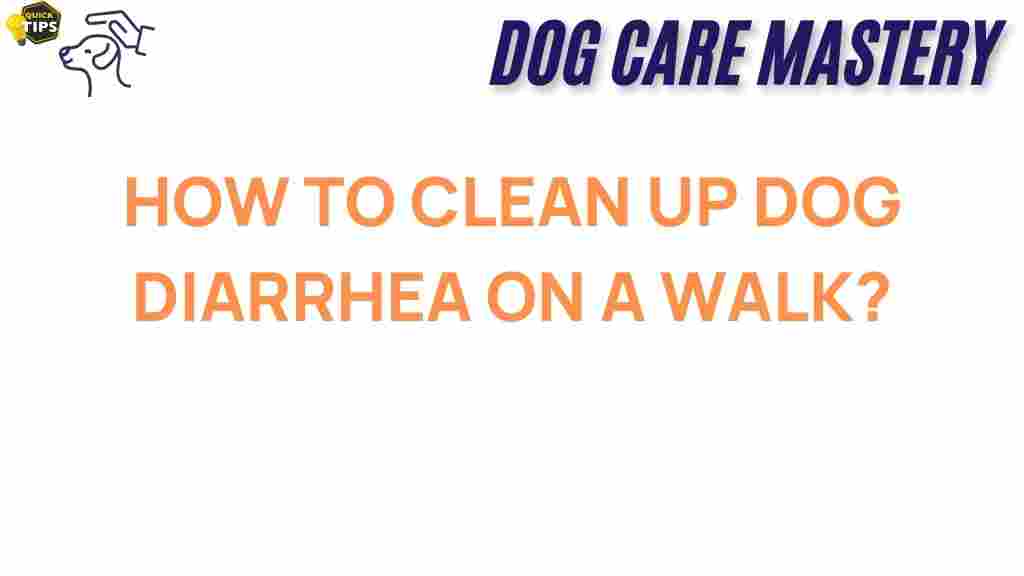Mastering the Art of Cleaning Up Dog Diarrhea
As a dog owner, there are few things more distressing than noticing your beloved pet has an upset stomach, especially when it happens during walks. **Dog diarrhea** can be messy and challenging to manage, but with the right tools and strategies, you can effectively clean up and keep your walks enjoyable. In this article, we will explore the best practices for dealing with dog diarrhea during walks, ensuring that both you and your pup can have a stress-free experience.
Understanding Dog Diarrhea
Before diving into cleanup techniques, it’s essential to understand what dog diarrhea is and its potential causes. Diarrhea in dogs can occur for several reasons:
- Dietary indiscretion (eating something they shouldn’t)
- Food allergies or intolerances
- Infections (bacterial or viral)
- Parasites
- Stress or anxiety
- Health issues (e.g., pancreatitis or inflammatory bowel disease)
If your dog experiences diarrhea frequently, it’s crucial to consult a veterinarian to rule out any underlying health issues. However, if it happens occasionally, being prepared can make the cleanup process much easier.
Preparing for Walks
Preparation is key when heading out with a dog prone to diarrhea. Here are some tips to ensure you’re ready:
- Bring the right supplies: Always carry waste bags specifically designed for dog waste. Some brands offer biodegradable options for eco-conscious pet owners.
- Invest in a portable clean-up kit: Consider packing a small kit that includes gloves, disinfectant wipes, and paper towels. This will make dealing with accidents more manageable.
- Know your dog’s behavior: Learn to recognize the signs that your dog might need to relieve themselves. This can help you anticipate and prepare for potential accidents.
Step-by-Step Process for Cleaning Up Dog Diarrhea
When the unexpected happens, follow these steps to clean up dog diarrhea effectively:
Step 1: Stay Calm and Assess the Situation
First, take a deep breath. It’s important to remain calm. Assess the situation and determine how bad the mess is. If it’s a small spot, you may need fewer supplies than if it’s a larger mess.
Step 2: Use Gloves
Put on disposable gloves to protect your hands from bacteria and parasites that may be present in the diarrhea. This is a crucial step in maintaining hygiene.
Step 3: Pick Up the Mess
Using a waste bag, carefully pick up the diarrhea. Turn the bag inside out over your hand, encasing the mess, and tie it securely. If the mess is particularly runny, use paper towels to scoop up as much as possible before sealing it in the bag.
Step 4: Clean the Ground
After you’ve disposed of the waste, use disinfectant wipes or a damp paper towel to clean the area where the diarrhea was. This step is essential to eliminate odors and bacteria. Make sure to dispose of the used wipes or paper towels in the same waste bag.
Step 5: Dispose of the Waste Properly
Once you’ve cleaned the area, dispose of the sealed bag containing the waste in a designated dog waste bin or your regular trash. Do not leave it on the ground, as this can be disrespectful to the environment and others using the space.
Step 6: Sanitize Your Hands
After finishing the cleanup, remove your gloves and dispose of them properly. Wash your hands thoroughly with soap and water, or use hand sanitizer if soap is not available.
Troubleshooting Tips
Even with the best preparation, things don’t always go as planned. Here are some troubleshooting tips for common issues related to dog diarrhea:
What if it Happens Again During the Walk?
If your dog has another incident, stay calm and repeat the cleanup process. Carrying extra supplies can make this less stressful.
How to Handle Diarrhea with No Supplies?
If you find yourself without cleanup supplies, look for nearby public restrooms or facilities that may have paper towels or trash bins. Alternatively, you can use a stick to push the mess into a nearby grassy area, ensuring it’s not in a place where others may step in it.
When to Seek Veterinary Help
If your dog has diarrhea for more than 24 hours, shows signs of dehydration, or exhibits other symptoms like vomiting or lethargy, contact your veterinarian immediately. Persistent diarrhea can lead to serious health issues.
Conclusion
Cleaning up dog diarrhea during walks is an inevitable part of being a responsible pet owner. By being prepared and following the steps outlined in this article, you can manage this unpleasant situation with confidence. Remember that while dog diarrhea is often a minor issue, it can sometimes indicate a more serious health concern. Regular vet check-ups and monitoring your dog’s behavior and diet are essential for maintaining their overall health.
For more tips on dog care, check out our guide on keeping your dog healthy. And if you’re looking for environmentally friendly waste bags, consider exploring options at your favorite pet store.
With the right mindset and tools, you can master the art of cleaning up dog diarrhea and ensure that both you and your furry friend enjoy your walks together!
This article is in the category Behavior and created by dogcaremastery Team
